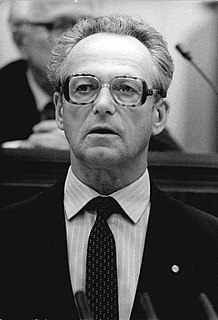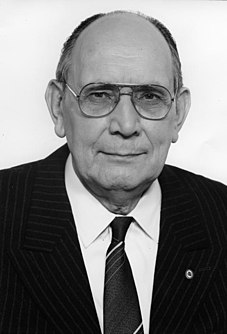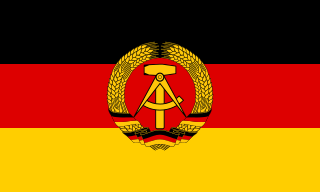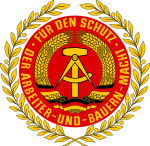
Erich Ernst Paul Honecker was an East German communist politician who led the German Democratic Republic from 1971 until shortly before the fall of the Berlin Wall in October 1989. He held the posts of General Secretary of the Socialist Unity Party of Germany (SED) and Chairman of the National Defence Council; in 1976, he replaced Willi Stoph as Chairman of the State Council, the official head of state. As leader of East Germany, Honecker had close ties to the Soviet Union, which maintained a large army in the country.

Walter Ernst Paul Ulbricht was a German communist politician. Ulbricht played a leading role in the creation of the Weimar-era Communist Party of Germany (KPD) and later in the early development and establishment of the German Democratic Republic in East Germany. As the First Secretary of the Socialist Unity Party from 1950 to 1971, he was the chief decision-maker in East Germany. From President Wilhelm Pieck's death in 1960 on, he was also the East German head of state until his own death in 1973. As the firm leader of the strongest and most important Communist satellite, Ulbricht had a degree of bargaining power with the Kremlin that he used effectively. For example he demanded the building of the Berlin Wall in 1961 when the Kremlin was reluctant.

The Socialist Unity Party of Germany, often known in English as the East German Communist Party, was the governing Marxist–Leninist political party of the German Democratic Republic from the country's foundation in October 1949 until its dissolution after the Peaceful Revolution in 1989. The party was established in April 1946 by the merging of the Communist Party of Germany and Social Democratic Party of Germany.

Egon Rudi Ernst Krenz is a former East German politician who was the last communist leader of East Germany during the final months of 1989. He succeeded Erich Honecker as the General Secretary of the ruling Socialist Unity Party of Germany (SED), but was forced to resign only weeks later when the Berlin Wall fell.

Wilhelm Stoph was a German politician. He served as Chairman of the Council of Ministers of the German Democratic Republic from 1964 to 1973, and again from 1976 until 1989. He also served as chairman of the State Council from 1973 to 1976.

Manfred Gerlach was a German jurist and politician, and the longtime leader of the East German Liberal Democratic Party. He served as Chairman of the Council of State and was thus head of state of East Germany from 6 December 1989 to 5 April 1990.
The German Democratic Republic was created as a socialist republic on 7 October 1949 and began to institute a government based on the government of the Stalinist Soviet Union. The equivalent of the Communist Party in East Germany was the Sozialistische Einheitspartei Deutschlands, which along with other parties, was part of the National Front of Democratic Germany. It was created in 1946 through the merger of the Communist Party of Germany (KPD) and the Social Democratic Party of Germany (SPD) in the Soviet Occupation Zone of Germany. Following German reunification, the SED was renamed the Party of Democratic Socialism (PDS), which eventually merged with the West German Electoral Alternative for Labor and Social Justice to form the modern Left Party.

Alfred "Ali" Neumann was an East German politician. He was a member of the Politburo of the Central Committee of the Socialist Unity Party of Germany, and for a short time, he was East German Minister of Materials Management.
The Council of Ministers was the cabinet and head of government of the German Democratic Republic from November 1950 until the country was reunified on 3 October 1990. Originally formed as a body of 18 members, by 1989 the council consisted of 44 members.

The German Democratic Republic (GDR), German: Deutsche Demokratische Republik (DDR), often known in English as East Germany, existed from 1949 to 1990. It covered the area of the present-day German states of Mecklenburg-Vorpommern, Brandenburg, Berlin, Sachsen, Sachsen-Anhalt, and Thüringen. This area was occupied by the Soviet Union at the end of World War II, with the remaining German territory to the west occupied by the British, American, and French armies. Following the economic and political unification of the three western occupation zones under a single administration and the establishment of the German Federal Republic in May 1949, the German Democratic Republic was founded on 7 October 1949 as a sovereign nation.

The State Council of East Germany was the collective head of state of the German Democratic Republic from 1960 to 1990.

Heinrich Gottlob "Heiner" Rau was a German communist politician during the time of the Weimar Republic; subsequently, during the Spanish Civil War, he was a leading member of the International Brigades and after World War II an East German statesman.
The Economic System of Socialism (ESS) was an economic policy implemented in East Germany between 1968 and 1970, which was introduced and led by the country's autocratic leader, Walter Ulbricht. It focused on high technology sectors in an attempt to make self-sufficient growth possible. Overall, centralized planning was reintroduced in the so-called structure-determining areas, which included electronics, chemicals, and plastics. Industrial combines were formed to vertically integrate industries involved in the manufacture of vital final products. Price subsidies were restored to accelerate growth in favored sectors.

The Scharnhorst Order was the highest medal awarded to members of the East German National People's Army (NVA). It was given for services to military or other strengthening of the German Democratic Republic (GDR). Established on 17 February 1966 by the Council of Ministers of the GDR, it was awarded until the dissolution of the GDR in 1990.

Ingeburg "Inge" Lange was an East German politician.

The Modrow government refers to the final socialist government of the German Democratic Republic (GDR), which was led by Socialist Unity Party (SED) official Hans Modrow from November 1989 until East Germany's first democratically elected government took power on 18 March 1990.

Gerhard Schürer was a leading politician in East Germany.

The East German Republic Day Parade of 1988 was a parade on Karl-Marx-Allee in East Berlin on October 7, 1988 commemorating the 39th anniversary of the establishment of East Germany. Minister of Defense of the GDR Army General Heinz Kessler inspected the parade and Army General Horst Stechbarth commanded the parade as the Deputy Minister of Defense. The leader of East Germany Erich Honecker and the Prime Minister of the GDR Willi Stoph attended the parade. The Central Band of the National People's Army performed the military marches.

The East German Republic Day Parade of 1989 was a parade on Karl-Marx-Allee in East Berlin on 7 October 1989 commemorating the 40th anniversary of the establishment of East Germany. This was the last East German Republic Day Parade and the last major East German political event with the regime falling mere weeks later. In Germany, this parade is remembered as the end of "the great period of military parades".

Horst Stechbarth was an East German politician and high-ranking military officer in the National People's Army, holding the rank of Army General (Armeegeneral). He was the Chief of the NVA's Landstreitkräfte and the ex officio Deputy Minister of Defense of the GDR. He was also a member of the Politbüro of the Central Committee of the ruling Socialist Unity Party of Germany (SED).










































